Mercedes-AMG SL 43 Revealed – First 4 Cylinder ’43’
Mercedes-AMG have made 4-cylinder cars before, but not for longitudinally-mounted setups.
When the all-new SL was unveiled, most of us realised that it had found its own niche as an AMG car. It was clearly not going to be destined for the lower rungs of society. We thought it would just come with a 4.0L twin turbo V8 and that would be the end of that.

But no! Now the company has shown a 2.0L 4-cylinder turbo version, mirroring the strategy used for the Jaguar F-Type. It is worth noting that this new Mercedes-AMG SL 43 will feature a mild-hybrid electrified powertrain with a 48V system for EQ Boost and better fuel consumption too. What’s more this 2-litre engine will feature AMG’s first electrically-powered exhaust gas turbocharger for more spontaneous throttle response and better efficiency.

The total output of this entry-level AMG roadster is an impressive 381hp and 480Nm of torque with a short term boost of 14hp in certain situations. This is the same M139 engine that’s used in the AMG A45, but this time it’s mounted longitudinally in the engine bay, sending power to the rear wheels via an 9-speed AMG Speedshift Multiclutch transmission.
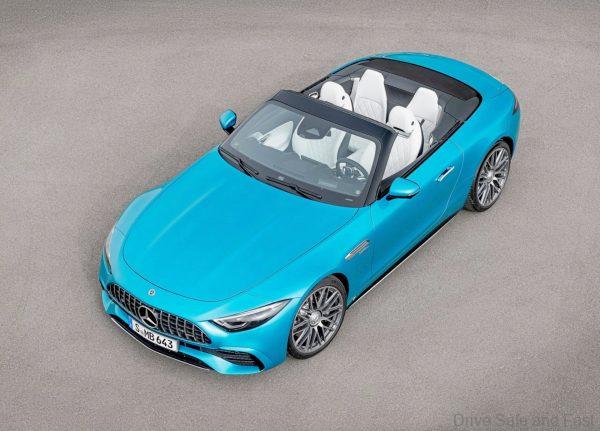
It features a wet start-off clutch for lower weight and better response during load changes. 0-100km/h is done in just 4.9 seconds and the AMG SL 43 has a stop speed of 275km/h.
Here’s the press release for more information.

PRESS RELEASE
In the 70 years of its development history, the SL experienced the transformation from a thoroughbred racing car to an open-top luxury sports car – and has long enjoyed legend status, not least for this reason. The new Mercedes-AMG SL now marks another milestone in the model’s history. It combines the distinct sportiness of the original SL with the unique luxury and technological excellence of the modern Mercedes-AMG models. As the new entry-level model in the series, the SL 43 is a particularly good example of this. It is the world’s first series-produced vehicle to feature an electric exhaust gas turbocharger. This technology comes directly from Formula 1™ and solves the trade-off between a small, fast responding supercharger that nevertheless achieves comparatively low peak power and a large supercharger with high peak power that only responds delayed. With its innovative engine concept, the new entry-level model of the 2+2-seater roadster is aimed more at particularly tech-savvy buyers. With its combination of a comparatively light four-cylinder engine on the front axle and rear-wheel drive, the SL 43 also displays distinctly discrete handling characteristics.
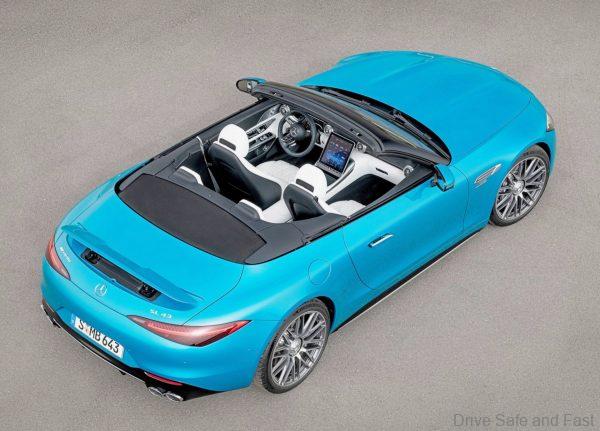
Roadster architecture with aluminium composite structure for typical AMG Driving Performance
The new SL of the R232 series is based on a completely new vehicle architecture developed by Mercedes-AMG. The new dimensional concept allows a 2+2 seating configuration for the first time since 1989 (Mercedes SL model series R129). This makes the new SL even more versatile. The rear seats increase daily practicality and offer space for people up to 1.50 metres tall (up to 1.35 metres with a child seat). If the extra seating is not needed, an insertable draft stop behind the rear seats can protect front-seat occupants from draughts on the back of their necks. Or the second row of seats can be used as additional stowage space and accommodate a golf bag, for example.
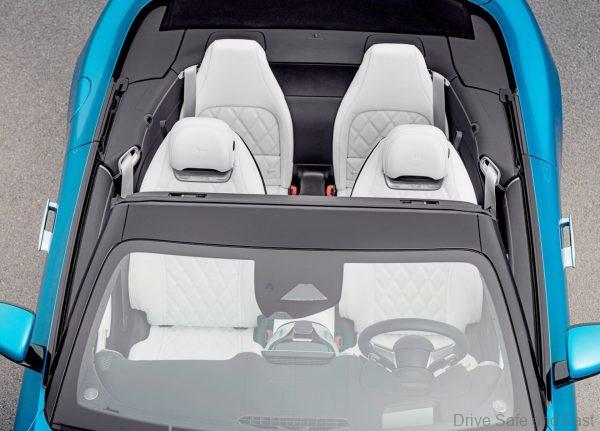
Constructed from lightweight aluminium composite, the chassis consists of an aluminium space frame with a self-supporting structure. The design guarantees maximum rigidity and is thus the perfect basis for precise driving dynamics, high comfort, optimal packaging and sporty body proportions. The aim of the body shell architecture is to realise the typical AMG Driving Performance with a focus on lateral and longitudinal dynamics, while at the same time meeting the high standards on comfort and safety.
In the new SL, the intelligent material mix enables the highest possible rigidity at a low weight. The materials used include aluminium, magnesium, fibre composites and steel, from which the windscreen frame is made, for example. This serves as roll-over protection in conjunction with the roll bar system behind the rear seats, which pops up at lightning speed when needed.
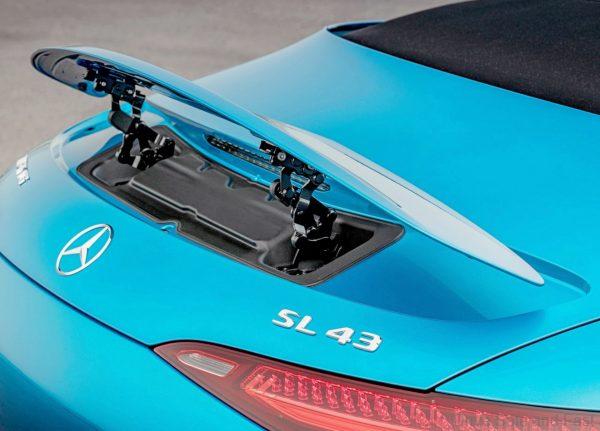
Compared to the previous model series, the torsional rigidity of the body shell structure was increased by 18 percent. The transverse rigidity is 50 percent higher than the already outstanding value of the AMG GT Roadster. The longitudinal rigidity is 40 percent higher. The weight of the body shell per se is only around 270 kilograms. Together with the low centre of gravity, the systematic lightweight construction ensures optimal driving dynamics.
Entry-level model with subtle distinguishing features in the exterior design
The exterior design of the SL 43 differs in individual details from the two eight-cylinder models. For example, it has differentiated front and rear aprons as well as round instead of angular double tailpipe trim. The defining features of the SL body design include the long wheelbase, the short overhangs, the long bonnet, the passenger compartment set further back with steeply raked windscreen, and the powerful rear end. This results in the typical SL proportions. They give the roadster its powerful, dynamic appearance – together with the voluminously modelled wheel arches and the large light-alloy wheels that are flush with the outer skin. The SL 43 runs on 19-inch light-alloy wheels as standard. In addition, the same range as for the eight-cylinder models is available as an option: aerodynamically optimised light-alloy wheels with diameters of 20 or 21 inches, which reduce air resistance through low turbulence. Particularly sophisticated are 20-inch wheels with plastic aero rings that save additional weight.

Active aerodynamics to increase dynamics and efficiency
A technical highlight for improving aerodynamics is the AIRPANEL active air control system. The horizontal louvres behind the upper air intake are electronically controlled and can be opened and closed with actuator motors. In this way, the airflow is directed according to demand, thus improving aerodynamic performance.
Normally the louvres are closed – even at top speed. This position reduces air resistance. Only once predefined components have reached certain temperatures and the demand for cooling air is particularly high do the louvres open and allow the maximum amount of cooling air to flow to the heat exchangers. This calls for highly intelligent and fast control.
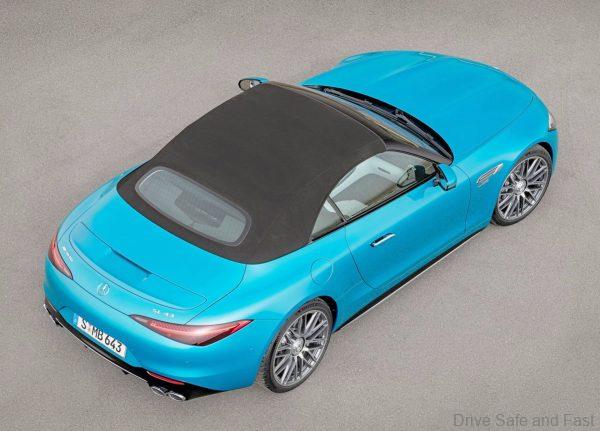
The same applies to another active component of the aerodynamics: the retractable rear spoiler seamlessly integrated into the vehicle profile. It changes its position depending on the driving status. In doing so, the control software takes into account numerous parameters: It factors the driving speed, the longitudinal and lateral acceleration and the steering speed into the calculation. The spoiler assumes five different angle settings from 80 km/h to either optimise the handling stability or reduce drag.
The optional Aerodynamics Package for the Mercedes-AMG SL 43 includes larger flics on the front and rear bumpers and a larger rear diffuser. This improves both downforce and aerodynamic drag even further. The modified speed thresholds of the rear spoiler and its steeper angle of attack of 26.5 degrees (instead of 22 degrees) in the Dynamic position also contribute to this.
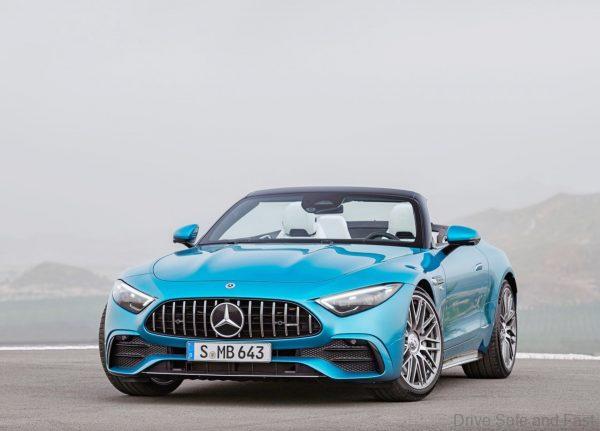
Fabric soft top for less weight and lower centre of gravity
The sportier positioning of the new SL also suggested the decision for an electric soft top instead of the previous metal vario-roof. The 21-kilogram reduction in weight and the resulting lower centre of gravity have a positive effect on driving dynamics and handling. The Z-fold saves space and weight, and makes it possible to dispense with a conventional soft-top compartment cover. The front header bow ensures that the open soft top is flush in its final position. At the same time, the developers were faced with the task of maintaining the high suitability for everyday use and the exemplary quiet-running. The three-layer design consists of a tightly stretched outer shell, a precisely finished roof liner and an acoustic mat made of high-quality 450 g/m² PES fleece inserted in between.
Opening and closing takes only about 15 seconds and is possible up to a speed of 60 km/h. The soft top is operated using the switch panel in the centre console or the multimedia touch screen, on which an animation shows how the process is progressing.
Interior with “hyperanalogue” cockpit and standard luxury seats
The interior of the Mercedes-AMG SL 43 also features an exciting combination of analogue geometry and the digital world – known as “hyperanalogue”. This is exemplified by the fully digital instrument cluster, which is integrated into a three-dimensional visor. The standard MBUX infotainment system offers a choice of several specific display styles and different modes. The symmetrical instrument panel is designed as a powerful wing and structured into an upper and lower section. The highlight are the four galvanised turbine nozzles. Their surfaces merge into the instrument panel in the form of powerful power domes. The lower section of the instrument panel evolves fluidly from the centre console, seamlessly connecting the two elements.
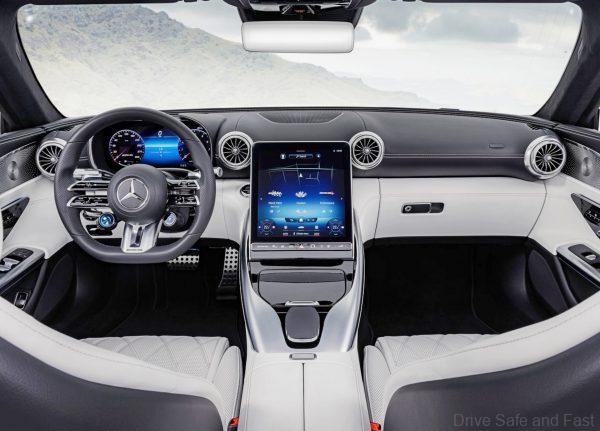
Despite symmetry, the cockpit design creates a clear focus on the driver: The high-resolution 12.3-inch LCD screen of the instrument cluster is not designed to be free-standing, but integrated into a high-tech visor that prevents reflections caused by sunlight. In order to avoid disturbing light reflections caused by different sun positions when the soft top is open, the tilt of the touch screen on the centre console can also be electrically adjusted from 12 degrees to 32 degrees.
The latest generation MBUX (Mercedes-Benz User Experience) is intuitive to operate and capable of learning. It offers a host of functional content and the operating structure of the second-generation MBUX system, which debuted in the new Mercedes-Benz S-Class. In the SL, extensive AMG-specific content in five display styles is added. Exclusive menu items such as “AMG Performance” or “AMG TRACK PACE” also emphasise the sporty character.
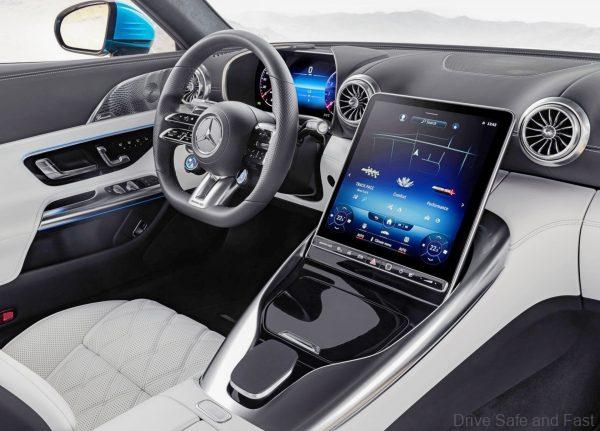
The SL 43 is equipped as standard with a wide range of electrically and manually adjustable luxury seats in a combination of ARTICO man-made leather and fabric. Seat covers in leather, NAPPA leather and NAPPA AMG leather are optionally available, as are AMG sports seats and AMG Performance seats with their sculptural design. The optionally available upholstery in MANUFAKTUR macchiato beige/titanium grey or in MANUFAKTUR truffle brown/black ensures a particularly exclusive touch. The AMG Performance seats can also be upholstered in a combination of nappa leather and DINAMICA microfibre with yellow or red decorative topstitching.
In addition to the standard high-gloss black, the trim elements and centre console are also available in aluminium or carbon and in MANUFAKTUR chrome black. The AMG Performance steering wheel with optional steering wheel heater is available in nappa leather and nappa leather/MICROCUT microfibre.
Newly developed chassis with multi-link front axle and innovative lightweight construction measures
As standard, the SL 43 is equipped with a newly developed AMG RIDE CONTROL steel suspension with particularly powerful aluminium shock absorbers and lightweight coil springs. The new SL is the first production vehicle ever from Mercedes-AMG to feature a multi-link front axle with five links arranged entirely within the rim. This significantly improves the kinematics. At the rear axle, a 5-link design likewise controls the wheels.
To reduce unsprung masses, all suspension links, steering knuckles and wheel carriers on the front and rear axles of the new SL are made of forged aluminium. The multi-link concept controls each wheel with the least amount of elastic movement. The high camber and track stability not only enables high cornering speeds, it also provides the driver with optimal road contact at the high cornering limit. This is reflected in excellent lateral dynamics and driving stability at high speeds as well as in the good-natured reaction to external influences such as crosswinds, bumps or jumps in friction coefficients.
The lightweight coil springs are a new development: special tempering allowed their weight to be lowered without reducing their performance. In the manufacturing process, the spring pad is glued onto the spring for the first time. This firm connection prevents wear and tear caused by dirt such as sand over the course of a vehicle’s life. The spring does not corrode over the life cycle, and the maximum component load can consequently be increased at less weight. This saves around 0.2 kilograms per spring.
Another lightweight construction measure concerns the torsion bar stabilisers on the front and rear axles of the SL 43. Thanks to a variable wall thickness, their weight can be reduced. The maximum wall thickness is now only used where it is required due to the maximum load, in this case in the area of the rubber mounts.
The latest generation of AMG adaptive adjustable damping is available as an option for the SL 43. The suspension control unit uses data analysis – including acceleration and wheel travel sensors – to adjust the damping force for each wheel in a few milliseconds to suit the situation. The driver can pre-select the basic set-up via the AMG DYNAMIC SELECT driving modes: at the touch of a button, the handling characteristics change, for example, from full dynamics in “Sport+” mode to smooth cruising in the “Comfort” setting. In addition, the tuning can be adjusted in three stages independently of the driving modes via a dedicated button.
AMG high-performance composite brake system for short braking distances
The newly developed AMG high-performance composite brake system guarantees excellent deceleration values and precise control. It impresses with short braking distances, sensitive response and last but not least with high stability and durability – even under extreme stress. Comfort functions include Hill Start Assist as well as pre-filling and dry braking in wet conditions. When the ignition is switched off and the vehicle is stationary, the parking position “P” is also activated. When starting off, the electric parking brake is released automatically.
The composite brake discs are particularly light: Driving dynamics and turn-in behaviour benefit from the reduced unsprung masses. Brake disc (made of cast steel) and brake disc pot (made of aluminium) are now connected with special pins. This design saves space, which is used for even better brake cooling. The directional perforation is also new: In addition to the weight saving and better heat dissipation, this solution scores points with a faster response in wet conditions as well as better pad cleaning after braking.
Optional rear-axle steering combines agility and stability
The Mercedes-AMG SL 43 can be equipped with active rear-axle steering (HAL) as an option. Depending on the speed, the rear wheels steer either in the opposite direction (up to 100 km/h) or in the same direction (faster than 100 km/h) as the front wheels. The system thus enables both agile and stable driving characteristics. The front-wheel steering ratio is more direct, making it easier to steer the vehicle at the limit with less steering effort.